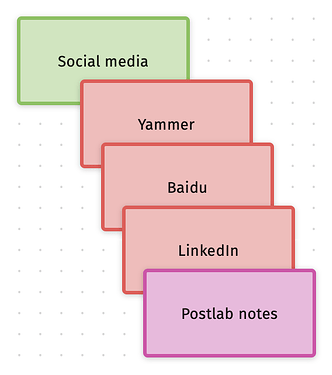I … really … like … this.
Again, it’s my feeling that JD has become this thing whose goal is to take you from the whole world and everything in it, through the levels of chaos, down and down, until you reach a place where you can do some work. That place being an ID.
Ref. this YouTube if you’ve not seen it.
So then the question to ourselves becomes: at the ID that I’ve found – 14.53 Social media – do I feel like I’m at that place? For me, currently, the answer is yes.
Alternatively, think about it like, if you were at work and someone new started. Hey Steve, go and brush up on that LinkedIn course, it’s in our social media folder. Just search the JDex, you’ll find it.
Steve’s going to find 14.53 and now, if there are a handful of folders for each of our social media platforms, and inside the one neatly labelled LinkedIn there are a handful of folders and one of them is Postlab course, is Steve going to be okay? I think he is.
So let’s ask ourselves, at what point might Steve be confused? Well if we have dozens of social media platforms and within each of those we have dozens of artefacts, that might be a bit stressful. He might not be able to find his things quickly, with more confidence, and less stress.
But at this point we’re really in to social media, clearly, and need to think about giving it more room than the meagre single ID we designed for it. We might even have hired Steve as Social Media Manager, it sounds like we need one. And so we probably promote it to 31 Marketing, PR, & comms and maybe even end up with a header 31.10 ■ Social media platforms.
So back to this notion of IDs-after-the-+. Here’s what I might do. Tell me if this is too cute.
I want 14.53+__ in the first instance. I don’t like the idea of using LI as a short identifier because, while 2 letters works for LinkedIn, it doesn’t work as well for other platforms. So what if I used 12, being the 12th letter of the alphabet? Then future stuff will sort above/below LinkedIn as appropriate.
(There’s an assumption here, which is that I’ll never have more than 26 social media platforms to manage. And not every one must get its ‘proper’ place in this list, it’s just a rough guide to keep L below A and above Z. So if I inexplicably start using LiveJournal, it’ll just have to be 13 and that’s fine.)
So we’re at 14.53+12 LinkedIn
Feels very neat indeed. It’s very obvious where we are. And now if I want those Postlab notes to have their own note, I don’t need a further ID. They don’t need one – this is more than enough. Because now I can extend-the-end of 14.53+12 with the pattern that is just a plus, a space, and the title of a note.
14.53+12+ Postlab course
Recap: the two styles of EtE
This needs its own blog post, which is on my list.
- Style 1:
AC.ID+ID <Title>
Here, after the + an ID immediately follows. No space. See above: 14.53+12.
Obviously in this case you created an additional ID that you can reference from anywhere.
Here, we don’t need an ID. We’re just typing additional notes on the main entry, but we want those notes in their own file. This is just like taking a single file that looks like this:
# 14.53 Social media
## LinkedIn
Just some notes yada yada.
## LiveJournal
Wait what?
## Yammer
Kill me now.
And turning it in to 3 files:
# 14.53+ LinkedIn
Just some notes yada yada.
# 14.53+ LiveJournal
Wait what?
# 14.53+ Yammer
Kill me now.
I find this much clearer than a long note with many headers and I’m using it liberally. In this case you did not create an additional ID that you can use anywhere.
Back to Postlab
The question is, do I need a unique ID to Postlab or am I just keeping notes on a LinkedIn thing? And the answer is the latter. So this is enough.
14.53+12+ Postlab course
And I think we’re done.
![]() but i don’t love it
but i don’t love it![]()


